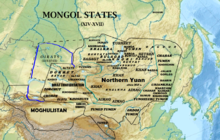Torghut
 |
|
| Regions with significant populations | |
|---|---|
|
|
106,000 |
|
|
14,176 |
| Languages | |
| Torgut dialect of Oirat | |
| Religion | |
| Tibetan Buddhism, Shamanism | |
| Related ethnic groups | |
| Mongols, especially Oirats | |
The Torghut (Mongolian: Торгууд/Torguud, "Guardsman" or "the Silks") are one of the four major subgroups of the Four Oirats. The Torghut nobles traced its descent to the Keraite ruler Tooril also many Torghuts descended from the Keraites.
They might have been kheshigs of the Great Khans before Kublai Khan. The Torghut clan first appeared as an Oirat group in the mid-16th century. After the collapse of the Four Oirat Alliance, the majority of the Torghuts under Kho Orluk separated from other Oirat groups and moved west to the Volga region in 1630, forming the core of the Kalmyks. A few Torghut nobles followed Toro Baikhu Gushi Khan to Qinghai Lake (Koke Nuur), becoming part of the so-called Upper Mongols. In 1698, 500 Torghuts went on pilgrimage to Tibet but were unable to return. Hence, they were resettled in Ejin River by the Kangxi Emperor of China's Manchu Qing dynasty. In 1699 15,000 Torghut households returned from the Volga region to Dzungaria where they joined the Khoits. After the fall of the Dzungar Khanate, one of their princes, Taiji Shyiren, fled west to the Volga region with 10,000 families in 1758. The name Torghut probably originates from the Mongolian word "torog" meaning "silk."
Due to harsh treatment by Russian governors, most Torghuts eventually migrated back to Dzungaria and western Mongolia, departing en masse on January 5, 1771. While the first phase of their movement became the Old Torghuts, the Qing called the later Torghut immigrants "New Torghut". The size of the departing group has been variously estimated between 150,000 and 400,000 people, with perhaps as many as six million animals (cattle, sheep, horses, camels and dogs). Beset by raids, thirst and starvation, approximately 85,000 survivors made it to Dzungaria, where they settled near the Ejin River with the permission of the Qing Manchu Emperor. The Torghuts were coerced by the Qing into giving up their nomadic lifestyle and to take up sedentary agriculture instead as part of a deliberate policy by the Qing to enfeeble them.
...
Wikipedia
